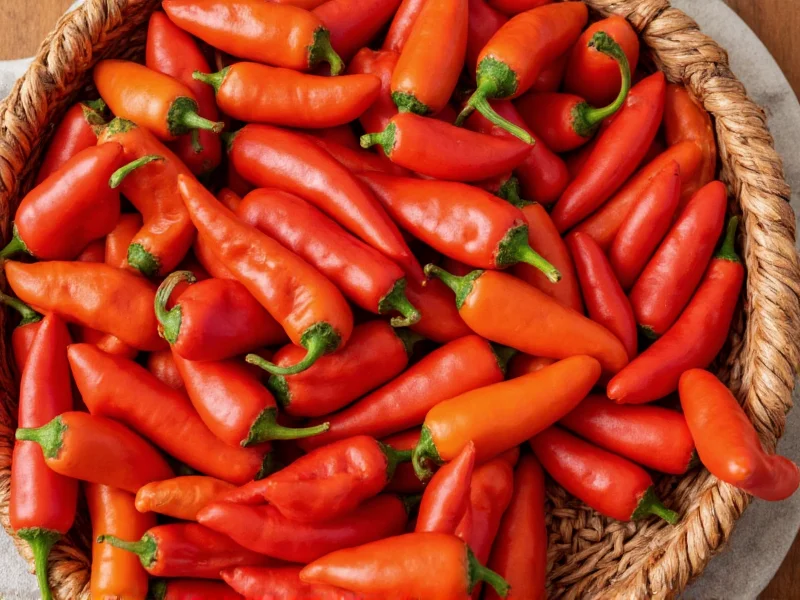Understanding pepper heat levels is essential for home cooks and culinary professionals alike. The Anaheim pepper, scientifically known as Capsicum annuum, serves as a versatile ingredient in Southwestern and Mexican cuisine. Despite occasional confusion with similar varieties, the Anaheim maintains a consistent position on the Scoville scale that makes it accessible for most palates.
Decoding the Scoville Scale for Pepper Enthusiasts
The Scoville scale, developed by pharmacist Wilbur Scoville in 1912, measures the concentration of capsaicinoids—the compounds responsible for a pepper's heat. Originally determined through human taste testing, modern measurements use high-performance liquid chromatography for precise quantification. Understanding where different peppers fall on this scale helps cooks select appropriate ingredients for their desired flavor profile.
Anaheim Pepper Heat Compared to Common Varieties
| Pepper Variety | Scoville Heat Units (SHU) | Heat Level Classification |
|---|---|---|
| Anaheim pepper | 500-2,500 | Mild to Medium |
| Poblano pepper | 1,000-2,000 | Mild |
| Jalapeño pepper | 2,500-8,000 | Medium |
| Serrano pepper | 10,000-23,000 | Medium-Hot |
| Habanero pepper | 100,000-350,000 | Very Hot |
Factors Influencing Anaheim Pepper Heat Variability
Several elements contribute to the range in Anaheim pepper spice level:
- Growing conditions: Soil composition, water availability, and temperature fluctuations significantly impact capsaicin production. Stressors like drought often increase heat levels.
- Ripeness: Green Anaheim peppers (harvested early) tend to be milder than their red-ripened counterparts, which develop more capsaicin over time.
- Genetic variation: Different cultivars exist within the Anaheim classification, with some naturally producing more heat than others.
- Individual pepper differences: Even within the same plant, heat levels can vary between peppers due to micro-environmental factors.
Culinary Applications of Anaheim Peppers
The moderate anaheim pepper spice level makes these chilies exceptionally versatile in the kitchen. Chefs appreciate their ability to add subtle warmth without dominating other flavors. Common uses include:
- Stuffed pepper dishes where the mild heat complements fillings without overwhelming them
- Roasted and peeled for chile rellenos, a classic Mexican dish
- Blended into sauces and salsas for Southwestern cuisine
- Added to soups, stews, and casseroles for gentle heat enhancement
- Used as a milder alternative to jalapeños in recipes where intense heat isn't desired
Anaheim vs. Poblano: Understanding the Heat Difference
Many home cooks confuse Anaheim peppers with poblanos, but their heat profiles differ noticeably. While both fall in the mild category, Anaheim peppers typically register slightly higher on the Scoville scale (500-2,500 SHU) compared to poblanos (1,000-2,000 SHU). The Anaheim's thinner walls also make it better suited for certain cooking methods, while poblanos' thicker flesh holds up better when stuffed. This anaheim pepper vs poblano heat comparison helps cooks select the appropriate pepper for their specific recipe requirements.
Practical Tips for Working with Anaheim Peppers
When incorporating Anaheim peppers into your cooking, consider these practical suggestions:
- Always taste a small piece before adding to recipes to gauge the specific heat level of your batch
- Remove seeds and white membranes for reduced heat, as these contain the highest concentration of capsaicin
- Roast over open flame or under broiler to develop complex flavors while maintaining their characteristic mild heat
- Store fresh peppers in the refrigerator's crisper drawer for up to three weeks
- Freeze roasted peppers for long-term storage without significant flavor degradation
Common Misconceptions About Anaheim Pepper Heat
Several myths persist about Anaheim pepper spice levels that deserve clarification:
- Misconception: All Anaheim peppers are extremely mild
Reality: While generally mild, some specimens can reach the upper end of their range (2,500 SHU), approaching jalapeño territory. - Misconception: Color determines heat level
Reality: While red-ripened peppers often have slightly more heat, color alone isn't a reliable indicator—growing conditions play a larger role. - Misconception: Size correlates with heat
Reality: Larger peppers aren't necessarily milder; heat depends more on environmental factors than physical size.
Substituting for Anaheim Peppers
When Anaheim peppers aren't available, consider these alternatives based on your desired heat level:
- For similar mild heat: Poblano peppers (slightly milder) or Hungarian wax peppers (when yellow, similar heat range)
- For slightly more heat: Early jalapeños (when still green and at the lower end of their range)
- For cooking applications requiring similar texture: Cubanelle peppers (even milder, around 100-1,000 SHU)
Understanding Regional Naming Confusion
An added complexity in discussing anaheim pepper spice level is regional naming differences. In California and the Southwest, these peppers are commonly called Anaheim peppers, while in New Mexico they're often labeled as "New Mexico chiles." Despite the different names, they represent the same cultivar with identical heat characteristics. This regional variation sometimes causes confusion when following recipes from different geographic areas.











 浙公网安备
33010002000092号
浙公网安备
33010002000092号 浙B2-20120091-4
浙B2-20120091-4